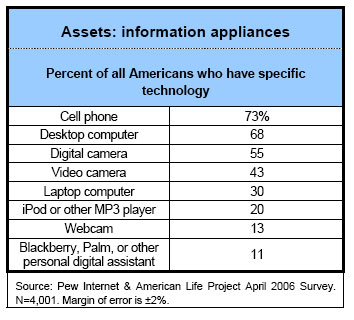Pew Report notes, part two: Social function does not translate into form

Functionality is at the center of the Pew Internet & American Life Project's new report, A Typology of Information and Communication Technology Users. The findings, which break out technology and communications users into 10 different groups with similar characteristics, demonstrate how many of today's leading edge features are still seeking engagement with those users.
The problem in the market, as I suggested in part one of this review, is a focus on functions that stand alone but lack involvement with the narrative of users' live.
It is, however, just a matter of time before some of the functionality we see today become a part of the Many social networks become the story, displacing the story of the participants.storyteller's toolset. Tying the things people do through "Web 2.0" to their whole life, rather than offering only fragments, is the key to creating a narrative from the bits and pieces we Flickr, Digg, Twitter, and so forth.
A few hardcore early adopters have excelled at this, turning themselves into stars and proving the value of narrative. But the rest of the market, as clearly explained by the Pew Project team, is not ready to see the connections and certainly not ready to do the work of forging the connections that tell a story.
What comes through clearly in the research that function alone does not suffice for many groups. Users are looking for experience in the form of context that makes their online actions more purposeful.
Take the group Pew calls "Lackluster Veterans," a predominantly male cadre with a median age of 40 with "a lot of online experience" that "seem content with surfing the Web or emailing family and friends, but they do not show great inclination to stretch their technology habits to self-expression or mobile media." What are the Lackluster Veterans missing, a sense of purpose that makes self-expression useful and valuable to them, is the essence of storytelling.

The cell phone is the device to which members of this group are most attached.... These second wave young adopters have fewer of the assets the more tech-oriented groups have.... The Mobile Centrics trail only Omnivores on measures of cell phone capacity; fully 88% have a cell phone that can play a game, and 72% have acell phone that can surf the internet. More than half (60%) have a cell phone that can take pictures, which is above the average of 28% among cell phone users. Four in ten (40%) have a cell phone that can play music.
That these people fall into the second tier of Net users is rather strange, as they clearly are deeply engaged with the network. But because the Pew survey counted the number of devices users possess to categorize intensity of usage it discounted engagement in this group. This seems to be confusing quantity with quality and depth of engagement with technology. It's a twist that over-emphasizes the importance of the device or devices one uses to connect to people and ideas with whom they identify.
Another group, the "Productivity Enhancers," have a story of their own that they tell through the use of digital devices with which they manage their time and productivity:
Perhaps because Productivity Enhancers are in very busy stages of their lives – in their early 40s, many with kids, nearly all with jobs – they may not have time to participate inmany online content creation activities or to try leading edge applications. The blogosphere is generally on the periphery of this group’s habits and it is very unlikely you will find Productivity Enhancers watching a “24” short clip on their cell phone or laptop.
The Pew questions have to do with the context in which online functionality becomes relevant to users. Context is the story that keeps users engaged with an activity such as posting to a blog or adding shout-outs to a MySpace page.
Early social networks—and we are still very early in this evolutionary process—have overemphasized functionality, because it is what can be built most easily. This accounts for the fact that most social networks become the story, displacing the story of the participants. People become involved in using a functionality because a friend recommends it to them, becoming a participant in doing something like "Twittering," but soon find they can't figure out what to do next. That's because the narrative of doing needs a purpose that sweeps in more than one's immediate actions to make sense.
Since most social networks are attempting to keep users' attention, they don't deal sufficiently with integrating the whole range of interests an individual user might have because they are built on domain-specific functionality. There's a simple way to understand why some social tools become hits, which I'll discuss tomorrow.